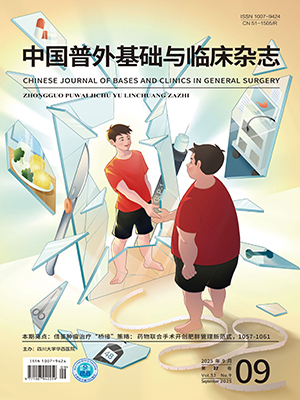| 1. |
Modlin IM, Lye KD, Kidd M. A 5-decade analysis of 13 715 carcinoid tumors [J]. Cancer, 2003, 97(4): 934-959.
|
| 2. |
Scherübl H. Rectal carcinoids are on the rise:early detection by screening endoscopy [J]. Endoscopy, 2009, 41(2): 162-165.
|
| 3. |
Toth-Fejel S, Pommier RF. Relationships among delay of diagnosis,extent of disease, and survival in patients with abdominal carcinoid tumors [J]. Am J Surg, 2004, 187(5): 575-579.
|
| 4. |
Soga J. Early-stage carcinoids of the gastrointestinal tract:an analysis of 1 914 reported cases [J]. Cancer, 2005, 103(8):1587-1595.
|
| 5. |
钟芸诗, 周平红, 徐美东, 等. 套扎器法内镜黏膜下切除术治疗直肠类癌患者三年疗效评价 [J]. 中华医学杂志, 2007,87(21): 1452-1456..
|
| 6. |
Maggard MA, O’Connell JB, Ko CY. Updated population-based review of carcinoid tumors [J]. Ann Surg, 2004, 240(1): 117-122.
|
| 7. |
Kinoshita T, Kanehira E, Omura K, et a1. Transanal endoscopic microsurgery in the treatment of rectal carcinoid tumor [J]. SurgEndosc, 2007, 21(6): 970-974.
|
| 8. |
Jetmore AB, Ray JE, Gathright JB Jr, et a1. Rectal carcinoids:the most frequent carcinoid tumor [J]. Dis Colon Rectum, 1992,35(8): 717-725.
|
| 9. |
Modlin IM, Kidd M, Latich I, et a1. Current status of gastrointestinal carcinoids [J]. Gastroenterology, 2005, 128(6): 1717-1751.
|
| 10. |
Wang M, Peng J, Yang W, et a1. Prognostic analysis for carcinoid tumours of the rectum:a single institutional analysis of 106 patients [J]. Colorectal Dis, 2011, 13(2): 150-153.
|
| 11. |
Yoon SN, Yu CS, Shin US, et a1. Clinicopathological characteristics of rectal carcinoids [J]. Int J Colorectal Dis, 2010, 25(9):1087-1092.
|
| 12. |
Fahy BN, Tang LH, Klimstra D, et a1. Carcinoid of the rectum risk stratification (CaRRS):a strategy for preoperative outcome assessment [J]. Ann Surg Oncol, 2007, 14(2): 396-404..
|
| 13. |
Ono A, Fujii T, Saito Y, et a1. Endoscopic submucosal resection of rectal carcinoid tumors with a ligation device [J]. Gastrointest Endosc, 2003, 57(4): 583-587..
|
| 14. |
周平红, 姚礼庆, 钟芸诗, 等. 直肠类癌的内镜超声诊断和内镜黏膜下切除 [J]. 中华消化内镜杂志, 2006, 23(3): 175-178.
|
| 15. |
Moon JH, Kim JH, Park CH, et a1. Endoscopic submucosal resection with double ligation technique for treatment of small rectal carcinoid tumors [J]. Endoscopy, 2006, 38(5): 511-514..
|
| 16. |
Kwaan MR, Goldberg JE, Bleday R. Rectal carcinoid tumors:review of results after endoscopic and surgical therapy [J]. Arch Surg, 2008, 143(5): 471-475..
|
| 17. |
张轶群, 周平红, 徐美东, 等. 内镜治疗直肠类癌的长期疗效[J]. 中华胃肠外科杂志, 2008, 11(5): 421-423..
|
| 18. |
Merg A, Wirtzfeld D, Wang J, et a1. Viability of endoscopic and excisional treatment of early rectal carcinoids [J]. J Gastrointest Surg, 2007, 11(7): 893-897..
|
| 19. |
Kobayashi K, Katsumata T, Yoshizawa S, et a1. Indications of endoscopic polypectomy for rectal carcinoid tumors and clinical usefulness of endoscopic ultrasonography [J]. Dis Colon Rectum,2005, 48(2): 285-291..
|
| 20. |
Ono H, Kondo H, Gotoda T, et a1. Endoscopic mucosal resection for treatment of early gastric cancer [J]. Gut, 2001, 48(2):225-229..
|
| 21. |
Tamura S, Nakajo K, Yokoyama Y, et a1. Evaluation of endoscopic mucosal resection for laterally spreading rectal tumors [J].Endoscopy, 2004, 36(4): 306-312..
|
| 22. |
Lee DS, Jeon SW, Park SY, et a1. The feasibility of endoscopic submucosal dissection for rectal carcinoid tumors:comparison with endoscopic mucosal resection [J]. Endoscopy, 2010,42(8):647-651..
|
| 23. |
Park HW, Byeon JS, Park YS, et a1. Endoscopic submucosal dissection for treatment of rectal carcinoid tumors [J]. Gastrointest Endosc, 2010, 72(1): 143-149..
|
| 24. |
Baek IH. Endoscopic submucosal dissection or conventional endoscopic mucosal resection is an effective and safe treatment for rectal carcinoid tumors:a retrospective study [J]. J Laparoendosc Adv Surg Tech A, 2010, 20(4): 329-331..
|
| 25. |
Corman ML 著. 杜如昱, 王杉, 汪建平主译. 结肠与直肠外科学 [M]. 北京:人民卫生出版社, 2009:968-970.
|
| 26. |
Kim BN, Sohn DK, Hong CW, et a1. Atypical endoscopic features can be associated with metastasis in rectal carcinoid tumors[J]. Surg Endosc, 2008, 22(9): 1992-1996..
|
| 27. |
Tsuboi K, Shimura T, Suzuki H, et a1. Liver metastases of a minute rectal carcinoid less than 5 mm in diameter:a case report [J]. Hepatogastroenterology, 2004, 51(59): 1330-1332.
|




